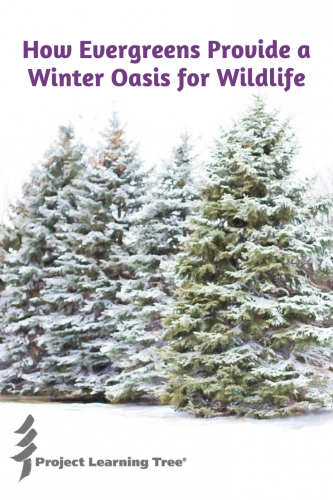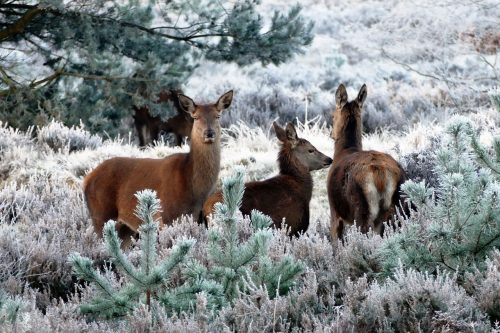 The changing of seasons in many parts of the country brings different characteristics to our landscape and to the wildlife that inhabits it. However, one group of trees remains steadfast in its commitment to photosynthesis by keeping its leaves all winter long: the evergreens.
The changing of seasons in many parts of the country brings different characteristics to our landscape and to the wildlife that inhabits it. However, one group of trees remains steadfast in its commitment to photosynthesis by keeping its leaves all winter long: the evergreens.
Evergreens give us a sprinkle of green color in the tree line. By keeping their leaves through the winter, evergreens provide food and shelter for the animals that must face harsh winter conditions.
Animals survive winter by either hibernating, migrating or adapting to the conditions. For animals that live in cold climates, finding food and shelter can be tough in the cold winter months. Many animals take advantage of a group of trees that retain their leaves year-round – the conifers.
While most coniferous forests are in the far north, many parts of the United States have patches of evergreen forests that are a winter “oasis” for wildlife. These evergreens provide food and shelter, the two most crucial needs, for many critters throughout the winter.
How evergreens help non-migratory birds in cold winters
Not all birds fly south for the winter. In the winter months, it can be difficult for birds to find shelter. When the temperatures drop, and the snow starts falling, overwintering birds need a place to escape the cold and wind.
Evergreen trees and shrubs are crucial winter habitats for birds. Coniferous trees provide a place for birds to hide from the cold and protection from precipitation. Many retain their berries into the winter months, providing an essential food source to nonmigratory birds.
The black-capped chickadee is an excellent example of a non-migratory bird that has taken advantage of a seasonal niche. Competition for available resources is much lower after most birds have migrated south. Black-capped chickadees are able to use pine trees for shelter and enjoy the berries that are still attached to the branches of trees, without having to compete with other species of birds.
Deer use evergreen trees as shelter
 Birds are not the only animals that use evergreens for shelter in the winter. Many species of coniferous trees provide shelter as well as food in the winter season for mammals such as the white-tailed deer. Stands of coniferous trees provide areas for deer to rest and eat. Since evergreens retain their needles in the winter, snow is able to build up to provide wind resistance and cover.
Birds are not the only animals that use evergreens for shelter in the winter. Many species of coniferous trees provide shelter as well as food in the winter season for mammals such as the white-tailed deer. Stands of coniferous trees provide areas for deer to rest and eat. Since evergreens retain their needles in the winter, snow is able to build up to provide wind resistance and cover.
Large stands of evergreens that provide shelter to deer are sometimes referred to as “deer yards.” They can encompass many acres – possibly hundreds of acres. The main characteristic of a deer yard is the continuous coniferous canopy, which helps the deer by reducing wind chill and creating an insulated ceiling when snow builds up on the branches. The branches also catch the snow before it hits the forest floor, which makes it easier for the deer to walk around the understory.
Evergreen trees provide food for many types of animals
Conifers play a special role in supporting wildlife in the winter by providing a much-needed source of food. Needles, twigs, bark, and seeds contained in the cones provide nourishment for wildlife. Chipmunks and squirrels enjoy eating the seeds of pinecones. Deer and black bears sometimes enjoy a snack of tree bark. Some species of woodpeckers stick around to peck into the soft wood of pine trees in search of larvae. Owls can be heard in the cold winter air hooting from their roost in an evergreen.
Engaging students outdoors in winter
The cold weather may make us reluctant to head outside and experience the outdoors, but it is well worth the investment to encourage children to immerse themselves in nature whenever possible. Each season offers unique experiences and sensations, for humans and for wildlife.
While the leaves are missing from the deciduous trees, and the landscape is covered in a blanket of white, it can be much easier to find and observe wildlife. Finding engaging experiences for children can be as simple as starting a winter wildlife journal or making a scrapbook of sketches or photographs of the landscape. Below is a list of more ideas to get you excited about this beautiful season and how to share it with your students and children.
Conduct an evergreen inventory
Winter is a great time to head outside and assess evergreen availability in your area. How many evergreens are around you? Are they mostly trees or shrubs?
Search for local deer yards
Integrate social studies into your science lessons with Google Earth. You can work with students to use Google Earth to look at aerials that have been taken over the years by clicking on the “history” icon. Find an aerial of your area that was taken in the fall, winter, or early spring. Look for pockets of coniferous forests. Then, go to those areas in person to see if they are potential deer yards in your area. Look for signs that deer are using these potential deer yards. You could even set up game cameras to record wildlife activity. If you do not find any evidence of deer using this habitat, think of ways to attract the deer to this area.
Winter tree identification
Have your students mastered tree identification in the summer, while all the trees have their leaves? Challenge them to tackle winter tree identification. They will easily recognize some of the taxonomical characteristics they may have missed in the summer months.
Take a winter walk in the woods
As you walk, talk about the winter landscape and look for ways it is different from the summer landscape. What’s missing? What’s the same?
Experience how evergreen trees offer a sensory overload by having children touch, smell, see, hear, and taste the season of winter. Consider trying these experiences year-round in areas with or without snow by downloading our abridged “Evergreens in Winter” family activity in English or Español.
Look for tree skeletons
Take a close look at both the coniferous and the deciduous tree shapes. Normally, the shapes of the deciduous trees are hidden by their leaves. In the winter, their shape is much easier to see. Sketch the trees and try to relate it to common shapes. The Tilth Alliance has excellent resources for identifying deciduous trees in the winter.
Observe and identify buds
Buds are next year’s leaves and flowers wrapped in a tough, protective package. They provide a head start for the next growing season. When the weather and daylight conditions are favorable, the buds begin to lengthen, and leaves begin to unfold. Look for buds on trees and shrubs. Make sketches of each and try to note their differences. Visit the trees and shrubs again in the spring to watch the new growth as it unfolds.
Search for nests
With the absence of deciduous leaves, nests are much easier to spot in the winter. Nests can be found in both coniferous and deciduous trees. Since they are uninhabited at this time, it is a great opportunity to take a closer look at the shape and form of nests constructed by different animals. What types of materials do you see in the nests? What type of bird or animal do you think lives in that nest?
The Northern Woodlands website has an excellent resource for identifying birds by the nests they build.
Look and listen for animals
Forests look and sound much different in the winter. There are fewer leaves to absorb sounds, and there are fewer animals in the woods to make noise. This is an excellent opportunity to make observations about the animals that depend on evergreens over the winter.
Look for evidence of animals
It is much easier to spot animal tracks and scat in the snow. Use this as an opportunity to learn how to identify tracks of native mammals. The Old Farmer’s Almanac has a downloadable resource to help you identify animal tracks. Students will love learning to identify animal scat with Boys Life Magazine’s excellent online resource.
Sketch, journal, and photograph
Winter is a time of beauty. Record the season with your thoughts, sketches, and photographs. Return to the same places throughout the seasons to observe changes.
Go on a winter scavenger hunt
Embrace the refreshing cold with some outdoor fun with some outdoor exploration. Search for printable scavenger hunts to get you started.
Write a story
Provide your students with creative and engaging writing prompts that use their imagination. Add illustrations, write a song, or create a drama about the challenges wildlife face in the winter and how the evergreens help.


